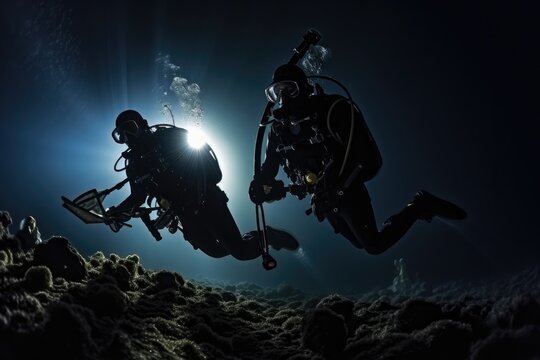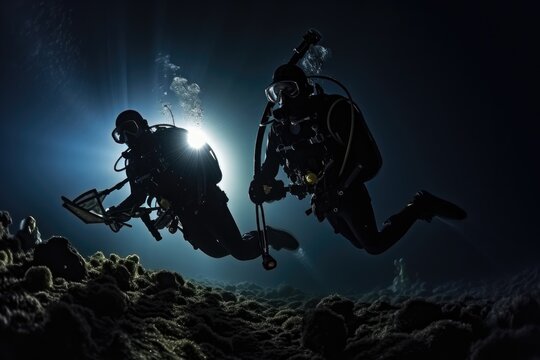10 Best Destinations for Night Divers
Night diving is a thrilling experience that unveils the ocean's hidden secrets and showcases marine life in a completely different light. As the sun sets, a new cast of underwater creatures emerges, creating a mesmerizing and unique spectacle. For those who have taken night classes to master this specialized form of scuba diving, the world offers numerous stunning destinations perfect for night dives. Here are the 10 best destinations for night divers.
1. Kona, Hawaii
Kona, located on the Big Island of Hawaii, is renowned for its spectacular night dives, particularly the famous Manta Ray Night Dive. This dive site attracts manta rays by the dozens, thanks to the abundant plankton illuminated by dive lights. These gentle giants glide gracefully through the water, providing an awe-inspiring display for divers. With crystal-clear waters and professional dive operators, Kona is a must-visit destination for night diving enthusiasts.
Highlights:
Manta Ray Night Dive
Abundant marine life
Clear waters and professional dive operations
2. Great Barrier Reef, Australia
The Great Barrier Reef is one of the most iconic diving destinations in the world, and its allure doesn't fade when the sun goes down. Night classes for diving can prepare you for the unique experiences found here, such as witnessing the coral spawning event. During a night dive on the Great Barrier Reef, you can encounter nocturnal creatures like reef sharks, giant trevally, and bioluminescent organisms that create a magical underwater light show.
Highlights:
Coral spawning event
Nocturnal marine life including reef sharks
Bioluminescent organisms
3. Bonaire, Caribbean Netherlands
Bonaire is a diver's paradise, known for its protected marine environment and incredible underwater visibility. The island's calm and clear waters make it ideal for night diving. The Hilma Hooker wreck and the Bari Reef are popular sites where you can see octopuses, tarpons, and vibrant corals. Bonaire's commitment to marine conservation ensures that the underwater ecosystem remains pristine and vibrant for night divers.
Highlights:
Hilma Hooker wreck
Bari Reef
Pristine marine environment
4. Cozumel, Mexico
Cozumel, located off the coast of Mexico's Yucatán Peninsula, offers some of the best night diving experiences in the Caribbean. Famous for its drift dives, Cozumel's currents bring nutrient-rich waters that attract a variety of marine life. At night, the reefs come alive with octopuses, lobsters, and the elusive splendid toadfish. The colorful coral formations and diverse marine life make Cozumel a top destination for night divers.
Highlights:
Drift dives
Octopuses and lobsters
Splendid toadfish
5. Anilao, Philippines
Anilao, situated in the heart of the Coral Triangle, is a hotspot for macro photography and night diving. The waters around Anilao are teeming with exotic critters like frogfish, nudibranchs, and flamboyant cuttlefish. Night classes can enhance your skills to capture these incredible creatures on camera. The vibrant and diverse underwater life makes Anilao a dream destination for night divers and underwater photographers alike.
Highlights:
Macro photography
Frogfish and nudibranchs
Flamboyant cuttlefish
6. Maldives
The Maldives is synonymous with luxury and stunning underwater landscapes. Night diving in the Maldives reveals a different side of its vibrant reefs. The Vaavu Atoll is particularly famous for night dives where you can see nurse sharks, manta rays, and bioluminescent plankton. The Maldives' warm waters and abundant marine life make it an ideal location for an unforgettable night diving experience.
Highlights:
Nurse sharks and manta rays
Bioluminescent plankton
Warm, clear waters
7. Roatán, Honduras
Roatán, the largest of the Bay Islands of Honduras, offers excellent night diving opportunities. The island's reefs are home to a variety of nocturnal creatures, including octopuses, crabs, and moray eels. The Blue Channel and West End Wall are popular night diving spots. Roatán's clear waters and vibrant marine life make it a fantastic destination for divers looking to explore the underwater world after dark.
Highlights:
Blue Channel and West End Wall
Octopuses, crabs, and moray eels
Clear waters and vibrant marine life
8. Palau
Palau is a renowned diving destination known for its rich marine biodiversity and stunning underwater landscapes. Night diving in Palau offers a chance to see unique marine life, such as the mandarin fish during its mating ritual. Sites like German Channel and Blue Corner come alive at night with nocturnal predators and bioluminescent organisms. Palau's crystal-clear waters and diverse marine life provide an exceptional night diving experience.
Highlights:
Mandarin fish mating ritual
German Channel and Blue Corner
Bioluminescent organisms
9. Red Sea, Egypt
The Red Sea is famous for its clear waters, vibrant coral reefs, and diverse marine life. Night diving in the Red Sea, particularly around Sharm El Sheikh and Hurghada, reveals a different side of these reefs. You can encounter Spanish dancers, lionfish, and nocturnal reef sharks. The Red Sea's calm conditions and stunning underwater scenery make it a top choice for night divers.
Highlights:
Spanish dancers and lionfish
Nocturnal reef sharks
Clear waters and vibrant coral reefs
10. Galápagos Islands, Ecuador
The Galápagos Islands are a unique and biodiverse diving destination, offering incredible night diving opportunities. Sites like Gordon Rocks and Cousins Rock are famous for their abundant marine life, including hammerhead sharks, sea lions, and nocturnal fish species. Night classes can prepare you for the challenging conditions and help you fully appreciate the underwater wonders of the Galápagos.
Highlights:
Hammerhead sharks and sea lions
Gordon Rocks and Cousins Rock
Abundant and diverse marine life
Conclusion
Night diving classes open up a whole new dimension of underwater exploration, allowing divers to witness the magic and mystery of the ocean after dark. Each of these destinations offers unique experiences and opportunities to encounter nocturnal marine life that is seldom seen during the day. Whether you're seeking the thrill of diving with manta rays in Kona or the serene beauty of the Great Barrier Reef at night, these locations provide unforgettable night diving adventures.
Enrolling in night classes can significantly enhance your diving skills and prepare you for these extraordinary experiences. With proper training and preparation, you can safely explore the wonders of the underwater world at night and enjoy the serenity and beauty that only night diving can offer. So, pack your dive gear, book your night classes, and get ready to embark on the adventure of a lifetime in these top night diving destinations.
For more information this website: https://maximum-scuba.com/night-diver-class

justicereport.news






